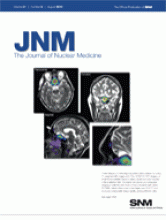Measuring tumor pH: Zhang and colleagues review the most recent advances in in vivo assessment with pH-sensitive PET radiotracers, MR spectroscopy, and MR and optical imaging. Page 1167

Beyond ejection fraction: Matsunari and colleagues provide an overview of current indications for implantable cardioverter defibrillators and describe the potential and challenges of 123I-MIBG imaging in predicting adverse events in patients after implantation. Page 1171
PET/CT in soft-tissue sarcomas: Benz and colleagues explore the utility of 18F-FDG PET/CT in correlating glycolytic phenotype and tumor grade in soft-tissue sarcomas and discuss potential contributions to sarcoma grading and targeting of biopsy sites. Page 1174

Phase alignment in cardiac PET/CT: Wells and colleagues evaluate a method to improve conventional realignment in cardiac PET/CT by acquiring a respiration-gated PET scan and separately aligning the 3D CT scan to each phase of the PET study.Page 1182
GLUT1 polymorphism and tracer uptake: Grabellus and colleagues investigate the relationship between single-nucleotide polymorphisms in the glucose transporter 1 gene and uptake of 18F-FDG and tumor aggressiveness in breast cancer. Page 1191

PET/MRI and intracranial masses: Boss and colleagues study the feasibility of tumor assessment of intracranial masses using a hybrid PET/MRI system that promises spatial and temporal coregistration of structural, functional, and molecular data. Page 1198
SPECT/CT planning for SIRT: Ahmadzadehfar and colleagues compare 99mTc-macroaggregated albumin SPECT/CT with planar imaging and SPECT in detection and localization of extrahepatic 99mTc-MAA accumulation and evaluate the impact of SPECT/CT on selective internal radiation therapy planning. Page 1206

Imaging and CTC counts in bone metastases: De Giorgi and colleagues compare the predictive significance of 18F-FDG PET/CT findings and circulating tumor cell count in patients with bone metastases from breast cancer treated with standard systemic therapy. Page 1213
Intraoperative real-time imaging: Vidal-Sicart and colleagues assess the value of a combination of a standard hand-held γ-probe and real-time imaging with a portable γ-camera in improving intraoperative detection in patients with difficult sentinel node localization assessed by presurgical lymphoscintigraphy. Page 1219
Smoking-induced occupancy of β2-nAChRs: Esterlis and colleagues use 123I-5-IA SPECT to measure nicotine occupancy and nondisplaceable binding to nicotinic acetylcholine receptors in healthy smokers after satiety. Page 1226

PET and infection: Vos and colleagues investigate whether 18F-FDG PET/CT can detect metastatic infectious foci in gram-positive bacteremia and whether such detection enhances clinical outcomes. Page 1234

Predicting ICD adverse events: Nishisato and colleagues examine whether impairment of cardiac sympathetic innervation and myocardial perfusion as assessed by 123I-MIBG and 99mTc-tetrofosmin imaging can predict lethal arrhythmic events in individuals implanted with cardiac defibrillators. Page 1241
PET and parkinsonism progression: Yagi and colleagues use PET assessment of changes in the brain dopaminergic system to identify pathophysiologic characteristics associated with early conversion from unilateral to bilateral parkinsonism. Page 1250
Collaboration on molecular imaging probes: Valliant highlights areas in which molecular imaging, in conjunction with probe development, new imaging technologies, and multidisciplinary collaborations, can have significant effects on health care and basic science. Page 1258

11C-mHED and PET: Law and colleagues describe the use of this PET tracer to resolve difficulties in imaging sympathetic nervous system dysfunction in mice and to visualize and assess experimental myocardial innervation. Page 1269

Cardiac PET/MRI in mice: Büscher and colleagues evaluate the suitability of a prototype preclinical PET/MRI system for simultaneous assessment of cardiac metabolism and function in mice. Page 1277
PET/CT in Trp53−/− mice: Walter and colleagues assess the utility of small-animal PET/CT for monitoring disease development and response to chemotherapy of thymic lymphoma in a transgenic mouse model. Page 1285

ImmunoPET of PSMA: Holland and colleagues report on the preparation of and initial studies with 89Zr-DFO-J591, a novel monoclonal antibody construct for targeted immunoPET and quantification of prostate-specific membrane antigen expression in vivo. Page 1293

TSPO ligands in infarcted brain: Yui and colleagues evaluate the kinetics of two 18F-labeled translator protein ligands and describe the results of their application in imaging neuroinflammation in the infarcted rat brain. Page 1301
18F-oleate as fat oxidation probe: DeGrado and colleagues investigate a novel tracer developed to assess fatty acid oxidation and discuss the implications for enhancing scientific understanding of a range of cardiovascular, oncologic, neurologic, and metabolic diseases. Page 1310

DNA repair after 131I therapy: Lassmann and colleagues study the induction, persistence, and disappearance of radiation-induced γ-H2AX and 53BP1 foci after 131I therapy and review the potential of these foci as markers for radiation exposure after radionuclide incorporation. Page 1318

ON THE COVER
These images of a meningioma patient were created by fusing T2-weighted MR images with 68Ga-DOTATOC PET images. A small frontal satellite lesion is clearly visible and was included in the irradiation field. Structural, functional, and molecular imaging in patients with brain tumors is feasible with hybrid PET/MRI, which offers many advantages over PET/CT and produces comparable image quality and quantitative data.
See page 1202.

- © 2010 by Society of Nuclear Medicine







